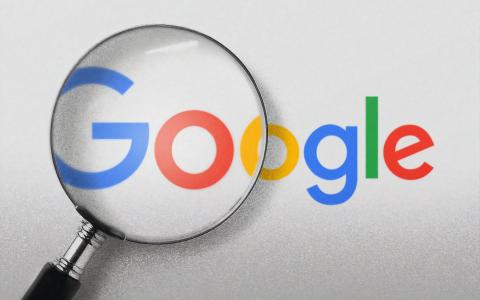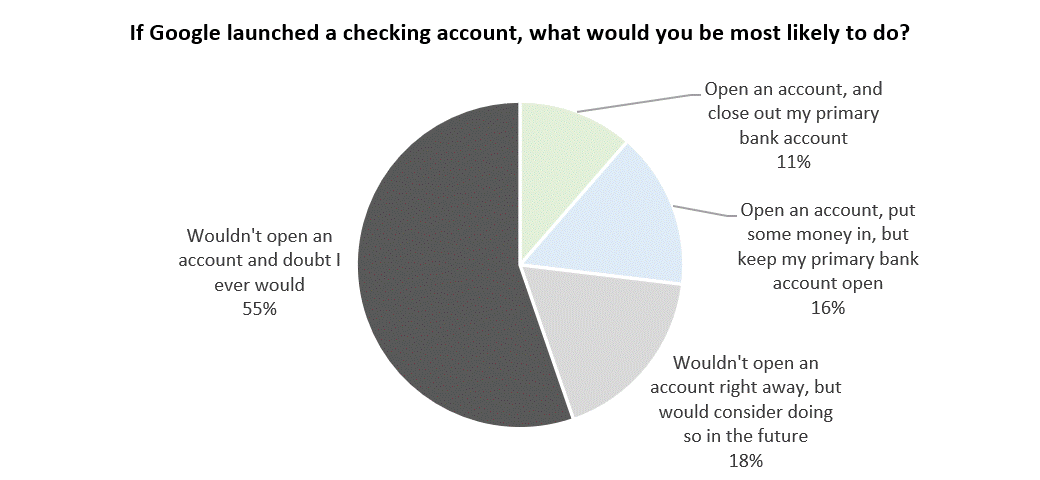
In November 2019, the Wall Street Journal reported:
“Google will soon offer checking accounts to consumers. The project is expected to launch next year with accounts run by Citigroup and a credit union at Stanford University, a tiny lender in Google’s backyard.”
The Big Tech firm inserted itself back into the news this month with the announcement of six new partners, and a new target date—2021— for the offering.
The prospects of a Google checking account raises two questions: 1) What, exactly, is it? 2) Do consumers want a Google checking account?
What Is a Google Checking Account?
Either nobody knows or they’re not telling.
A press release from one of the partnering banks states “Google will provide front-end, intuitive user experiences and financial insights based on their experience in building great user experiences.”
So I reached out to the new partners and asked: Have you seen demos or screen shots of this user experience? If so, what’s new and better about it? If not, what’s Google telling you will be in it and how it will be better than what banks offer today?
Here’s what I heard (and read):
“It’s too early to talk about features. What Google will provide has yet to be disclosed and discussed.”(Coastal Community Bank)
“The collaboration is in the early stages so we don’t have specifics in terms of user experience and content.” (BMO Harris)
“We are in the process of working with Google to co-create the best experience for our student customers so I have no details to share at this time.”(BankMobile)
“We are not able to share details at this juncture given that we want to save some of the specifics for the launch.” (BBVA)
My response was “You’re not ‘able to share details’ because you DON’T KNOW any of the details, do you?” Well, that was what I said in my head.
What Will a Google Checking Account Offer?
It’s anybody’s guess what a Google checking account will include, but my bet is that it will rival the Apple Card experience with:
- Streamlined account opening. Google will offer a fast and easy—OK, faster and easier—digital account opening (DAO) process that rivals what the challenger banks provide. It will be interesting to see if the banks have risk tolerance differences with Google.
- Real-time, contextual merchant offers.Card-linked offers has lost its luster over the past few years. And no wonder—the offers linked to my bank account are from a random list of merchants I don’t do business with. The problem is user experience. By integrating offers into Google Pay—and potentially into Chrome and even merchant apps through partnerships—Google could radically change the user experience.
- Financial insights. Expect Google to provide an eye-catching array of analyses around budgeting, spend analysis, cash flow, etc. Google and BBVA have already collaborated on an AI-powered engine to forecast consumers’ expenses and earnings which may show up in the Google app.
- A new banking experience. This is where the real innovation could happen. For years, banks have tried to integrate things (e.g., shopping, personal financial management, etc.) into their websites and mobile apps. A Google checking account could flip this on its head and integrate the banking experience into browser-based searches, shopping, the digital payment experience, and whatever else anybody does online.
Does Anybody Want a Google Checking Account?
In a July 2020 survey, Cornerstone Advisors asked consumers what they would do if Google offered a checking account. A little more than a quarter (27%) said they would open an account—with 11% saying they would make it their primary account.

Cornerstone’s study reveals insights into who would be interested in a “powered by Google” checking account:
1) Google Pay users. Among the 11% that would make a Google checking account their primary account, three quarters use Google Pay at least once a month, and almost half use it every week. In contrast, among consumers would consider opening a Google account in the future, just 16% are current Google Pay users.

Consumers who aren’t already using Google Pay are unlikely candidates for a Google checking account. And in Cornerstone’s study, just 7% of consumers are frequent Google Pay users (with another 12% categorized as “infrequent” users).
2) Affluent, well-educated men. Among the 11% that would make a Google checking account their primary account, three-quarters are men, 52% have a Master’s degree or higher, and 53% earn more than $100,000 annually.
3) Older than you think. It’s not Gen Zers looking for a cool new bank. Roughly one in six Millennials—and 13% of Gen Xers—said they would make a Google checking account their primary account.

4) Megabank customers. Two-thirds of the consumers that would make a Google checking account their primary account call one of the three megabanks—Bank of America, JPMorgan Chase, and Wells Fargo—their primary bank. Of those that would open a Google account as a secondary account, 57% bank with a megabank.
The Challenge With the Consumer Data
There are two problems with the consumer data: 1) Consumers don’t always do what they say they’ll do in a survey, and 2) Consumers are bad at envisioning the future.
As a result, it’s unlikely that 27% of consumers will open a Google account within three, or even six, months of a launch.
On the other hand, because consumers don’t have something tangible to respond to, consumers who might be enticed by the features I listed aren’t being counted.
That said, the data does provide valuable insights into which consumers will be the most likely to be the first adopters of the new account when it’s launched.
Selling Their Souls to the Devil?
Offering a Google checking account makes sense for large regional and mid-size financial institutions who are playing digital catch up to the large banks. They can certainly benefit from the whiff of innovation that sitting close to Google can provide. In addition, a Google partnership will help them reduce their cost of acquisition.
You have to wonder, though, if banks are selling their souls for the opportunity to partner with Google. As little more than the “provider of the banking license” what else are the banks bringing to the table?
I can hear some saying “our customer service” or “our knowledge of the local market.” Thankfully, they can’t hear me laughing.
Ironically, Google will be turning a whole bunch of financial institutions into bank-as-a-service providers.
The Impact of a Google Checking Account
The Google/bank checking account arrangement appears to be more of a partnership than a vendor relationship, but the latter is exactly where Google is heading: It wants to be a tech vendor.
In addition to the checking account offering, Google is developing a debit card, is offering banks an AI-driven loan processing tool, and is gaining traction with its cloud offering.
Google is tapping into systemic dissatisfaction with existing banking tech vendors. It thinks it can do better, and make a lot of money doing it.
The Google Vendor Edge
The company has a potential advantage over incumbent vendors. Although vendors often take credit for the revenue gains their clients realize, tech vendors’ impact is predominantly focused on the cost and productivity side of the business.
Google is different. It can help the acquisition and revenue side of the coin more so than any traditional tech vendor can.
For all the talk of Google getting into banking and putting banks out of business, the bigger threat is to tech vendors like FIS and Fiserv.
Will The Challenger Banks Be Impacted?
Here’s something counterintuitive: Challenger banks (i.e., Chime, Varo) aren’t likely to be impacted by a Google checking account any more than the megabanks will be.
According to Cornerstone’s study, 27% of digital bank customers expressed interest in a Google checking account—the same percentage as the rest of the population.
You’d think the percentage would be higher, no?
That just goes to show that digital bank customers choose digital banks for reasons other than the fact that they’re digital—reasons like higher interest rates, better PFM tools, and better debit card rewards.
This article originally appeared on Forbes.



